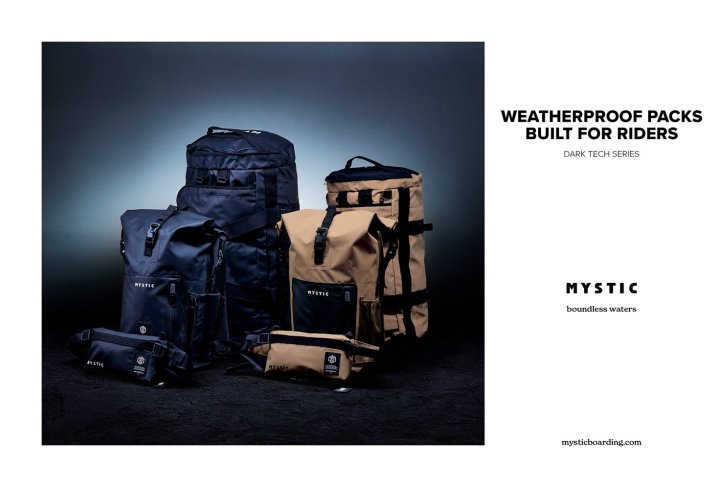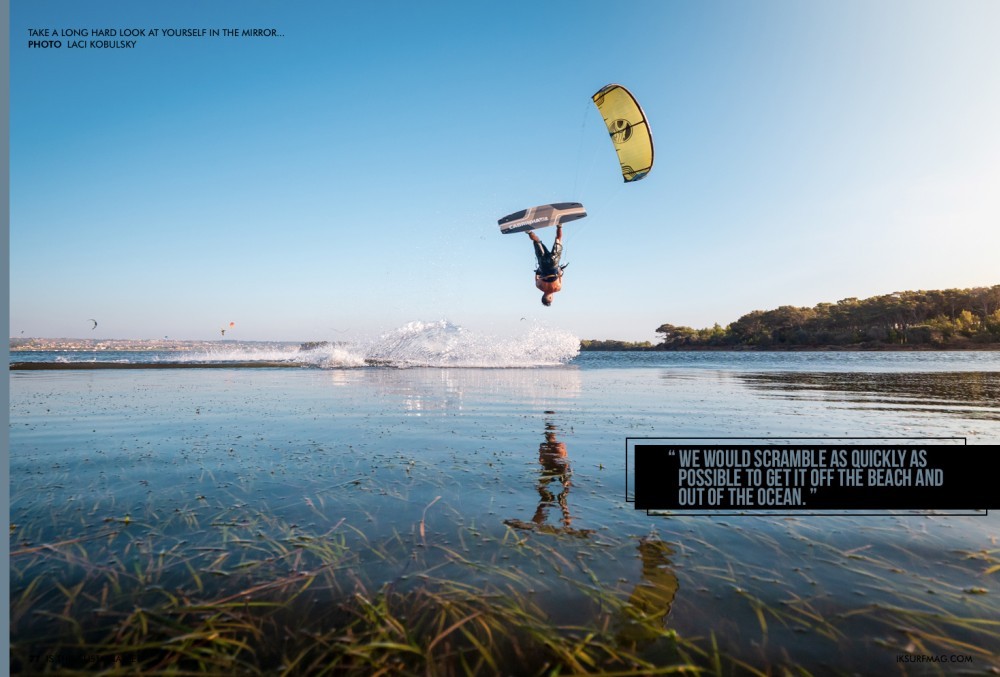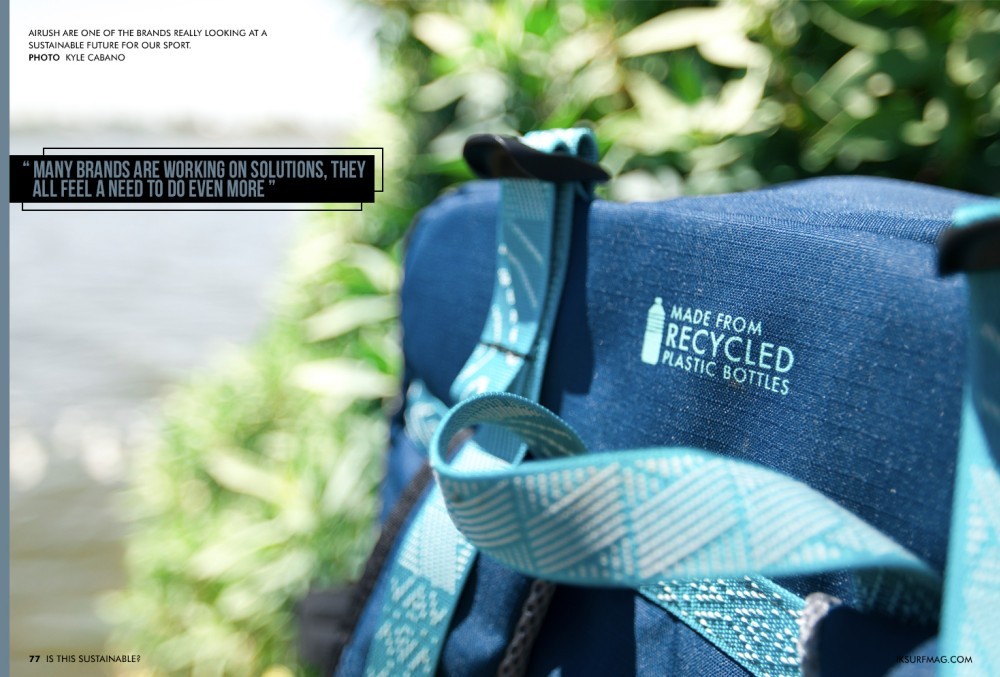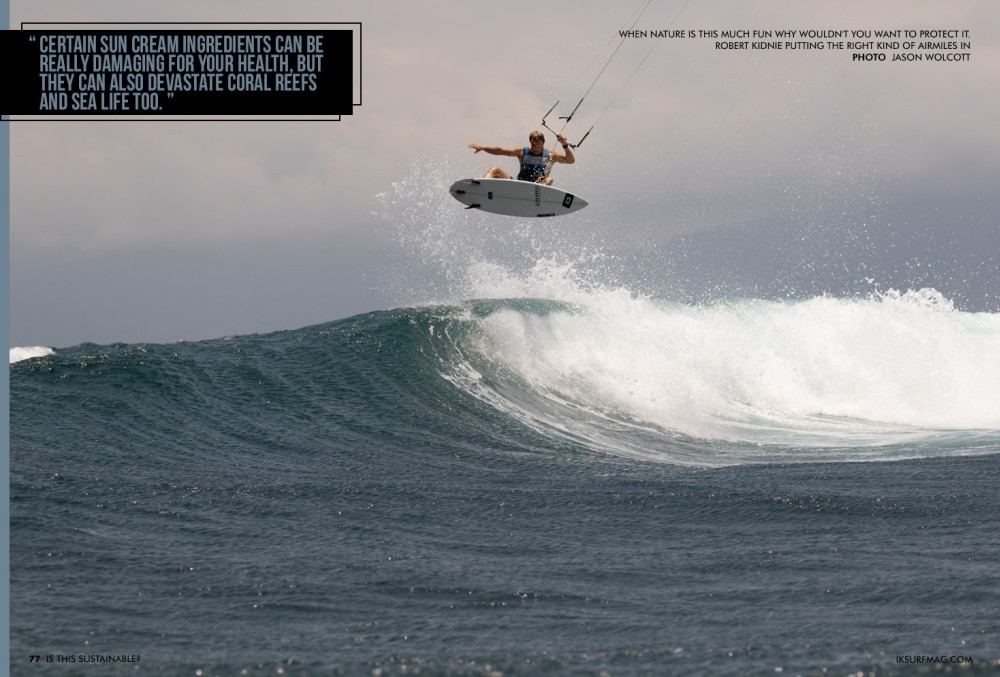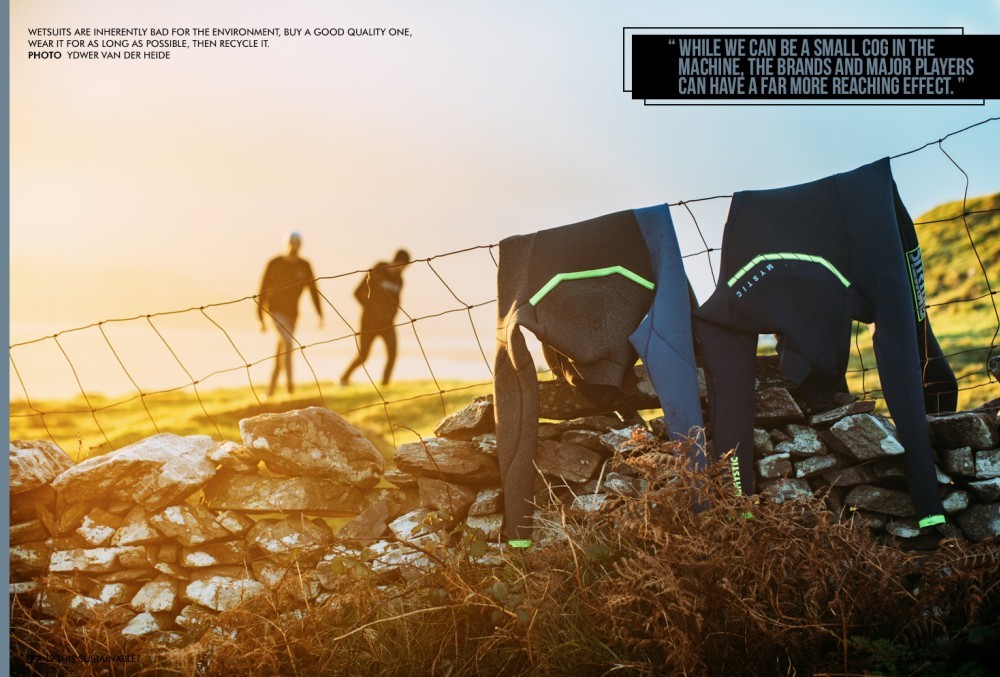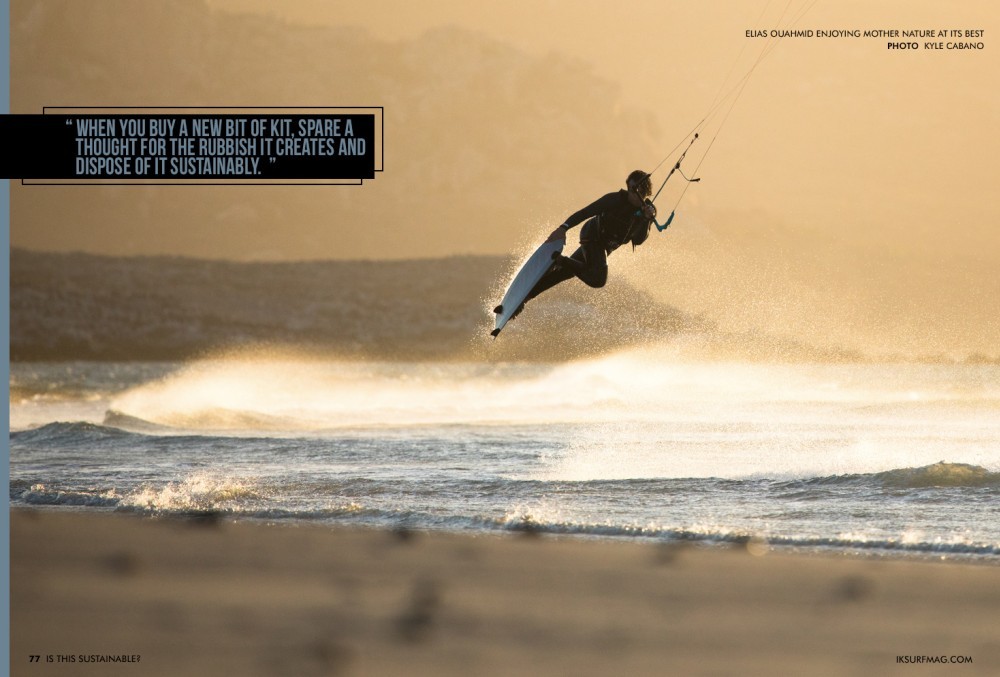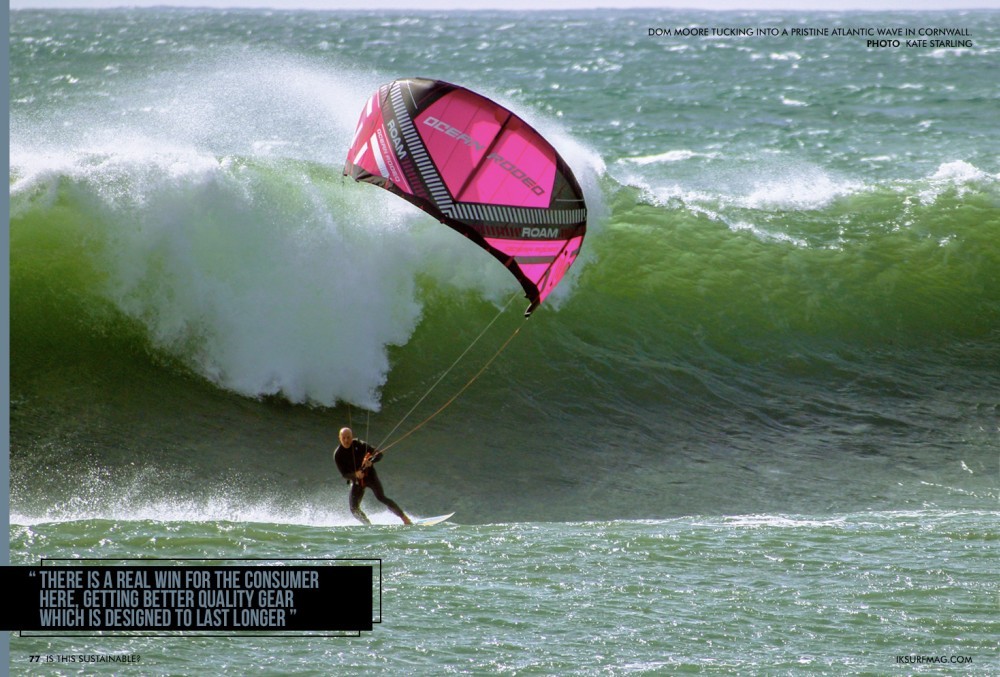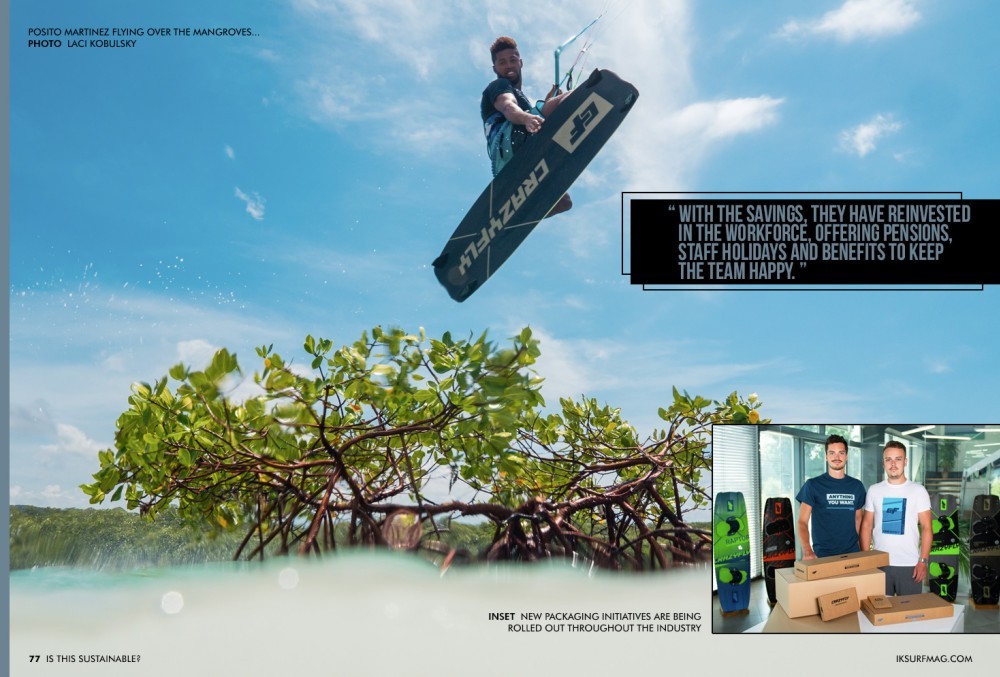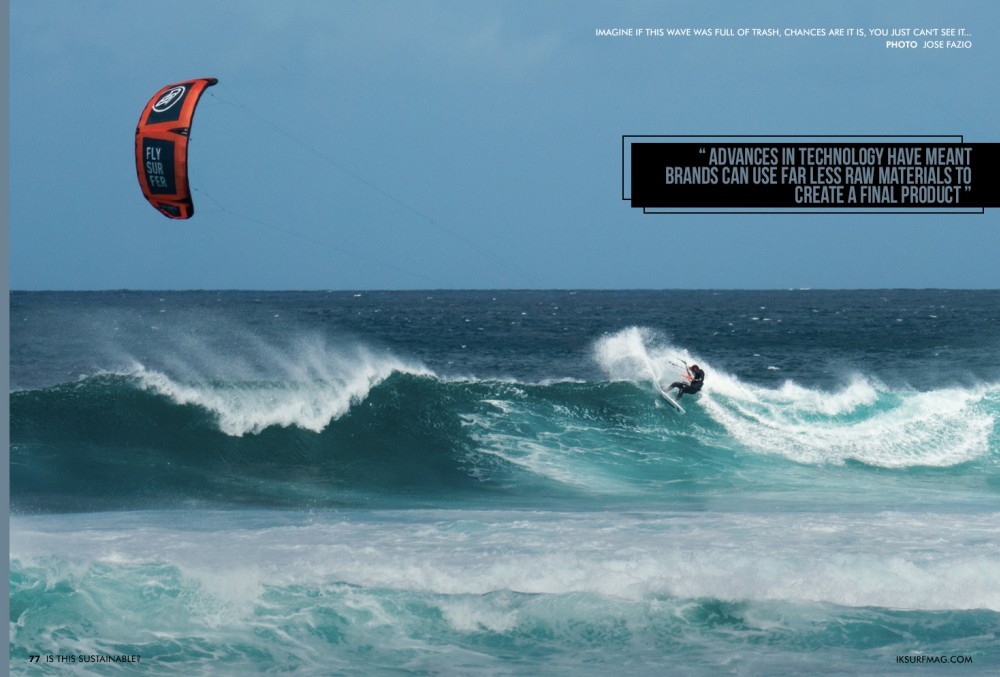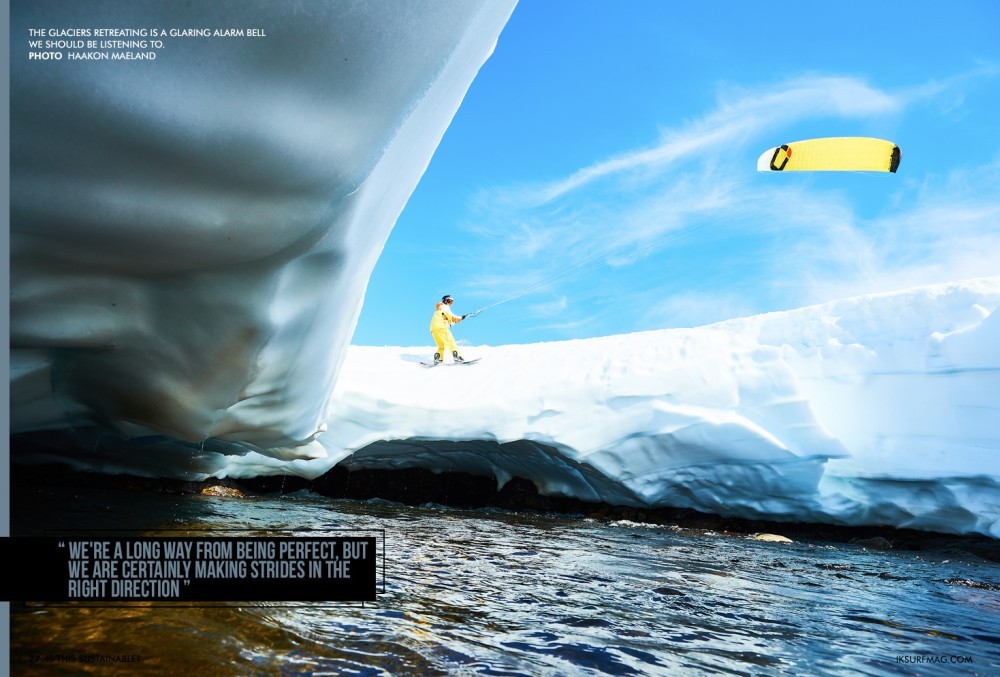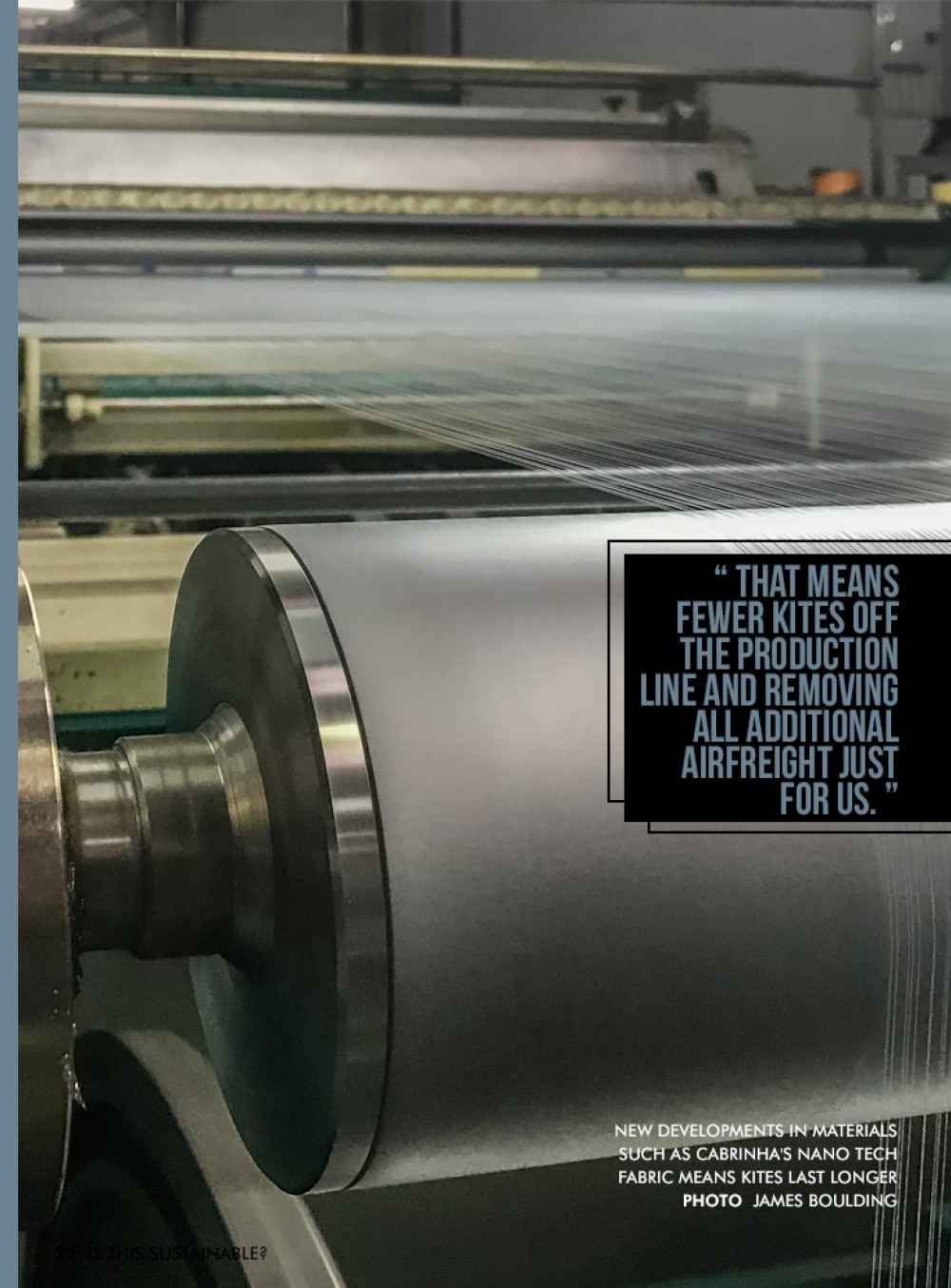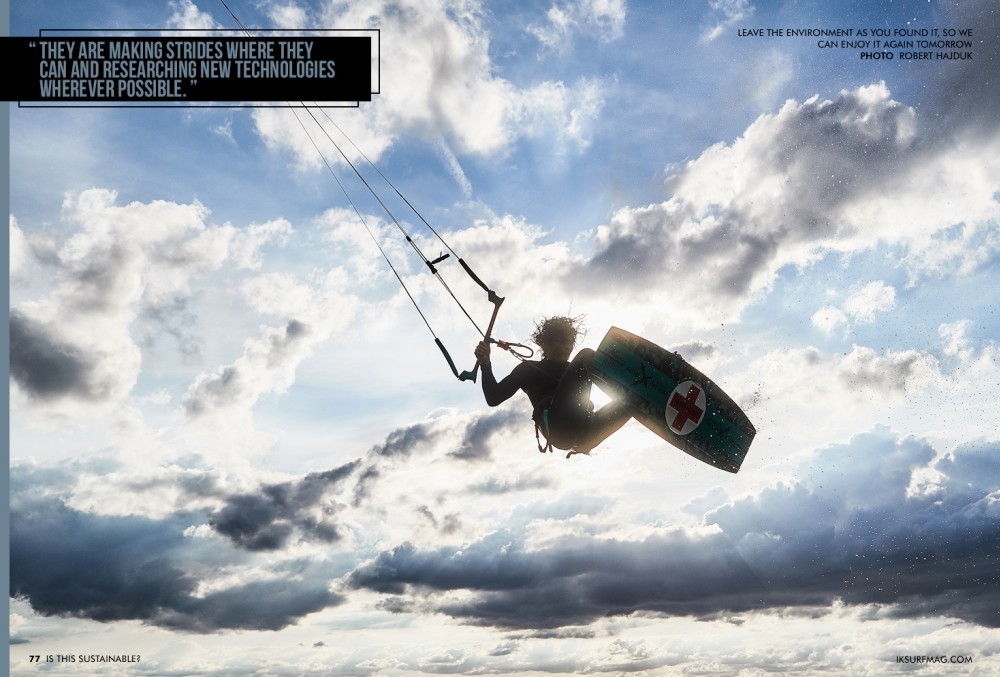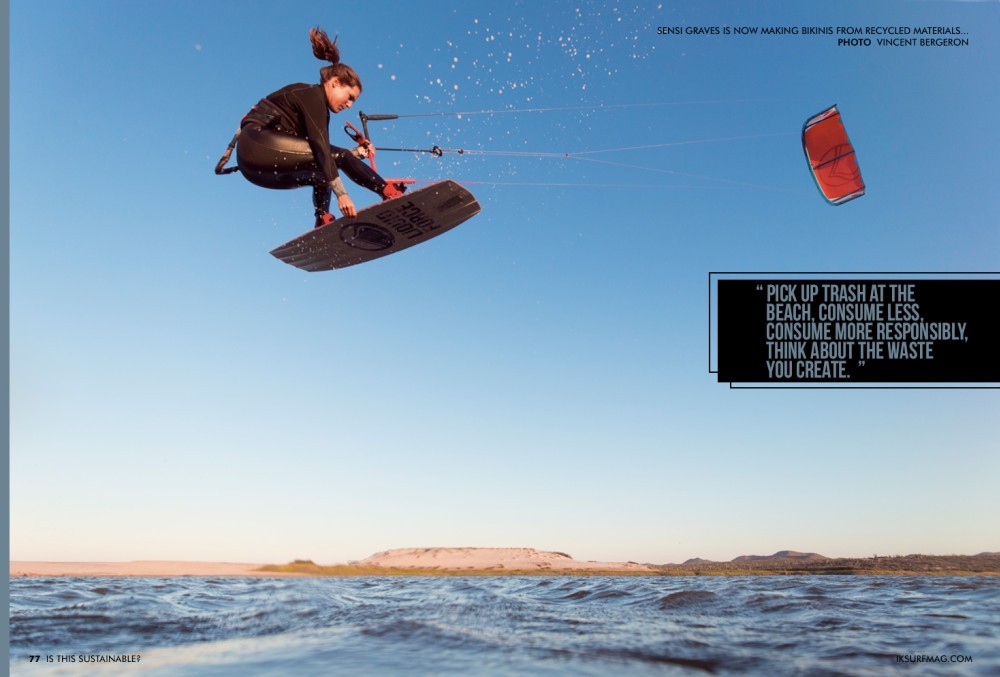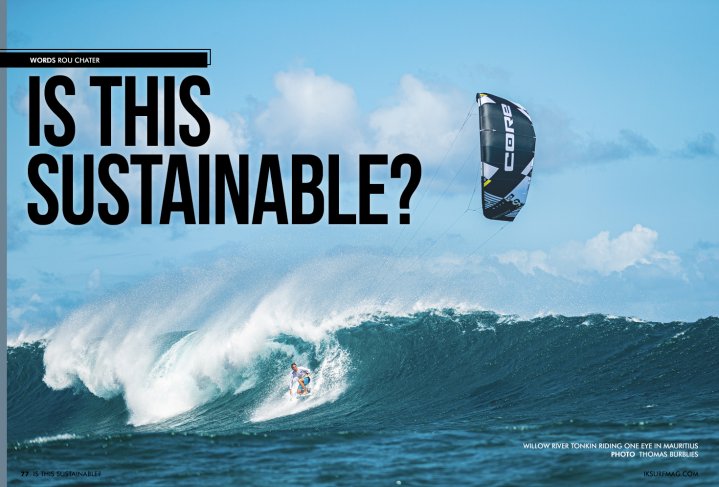
Is This Sustainable?
Issue 77 / Mon 14th Oct, 2019
Can we carry on as we are as a kiteboarding industry or do we need to make drastic changes to our habits and processes for our sport to become environmentally neutral? Join Rou Chater as he turns his journo mode on as he sets out to discover what is happening right now and what can be done moving forward.
Editor Rou Chater looks at the future prospects of kitesurfing as a sport, and how it impacts on the environment. It's no secret that the watersports industry uses some pretty hideous processes in its production, with the current focus on the climate, ocean and a viable, sustainable future he decided to speak to the brands to see what they were doing about it.
Sustainability, it's a word that comes up a lot. Brands are always talking about it, but are they actually doing anything about it? It's not as clear-cut as you think either, adopting one process, can impact on another. The whole thing is a seemingly bottomless pit of advantages and disadvantages.
As ocean lovers, we have a unique connection to the environment around us. Some people never leave the towns where they live, stay indoors and watch TV, flushing something down the toilet, such as sanitary products or wet wipes feels like a good way to rid yourself of something you don't want to see again. After all, if you aren't out there enjoying the environment we live in, it's easy to disconnect from it and not care.
Ask yourself when was the last time you saw something floating in the water that shouldn't have been there, it probably wasn't all that long ago. Depending on where you live and where you kite, it can be better or worse, but one thing is for sure if humans are about there will always be pollution in the ocean and on the beaches.
We used to spend a lot of time in Cabarete in the winter and Mary and I were forever doing beach clean-ups, especially after big storms which would wash all sorts of crap in off the ocean. If you left the rubbish on the beach a few days later the sea would take it away again, a solution the locals were happy with. To prevent the trash from going back into the sea, we would scramble as quickly as possible to get it off the beach and out of the ocean.
It left me with an unusual perception of humanity. There are two types of people in this world. Those that will see someone cleaning a beach and stop and help, and those that will look at you like it's your job and walk on by. OK, I get it, some people are too busy to help, but you know what, some people only stopped to help with a couple of bits of trash, taking a few minutes maximum, others stayed for the entire duration of the clean. We need this attitude now more than ever, think about what you can do for the environment at every opportunity rather than the other way around.
The chances are if you kitesurf then you already feel this affinity with Mother Nature and care about recycling, beach cleaning and living a more sustainable life. The good news is that the brands we work with care too, most of them are run by riders like you and I and while we will never get away from the corporate ethos of product for profit it is a lot more ethical than some industries out there.
The downside is that by its very nature, the materials used to create our toys are all pretty harmful to the environment. We sent a set of five questions to every brand we work with on our systems to see how they were working towards a more sustainable future.
The responses were incredibly interesting, and we have put the interviews in full on the website for you to read. To include it all here would fill the entire magazines with no room for anything else. Overall many brands are working on solutions, they all feel a need to do even more, and there is a great hope for the future that with advances in technologies and materials we can indeed become a sustainable sport at some point, although who knows how long that might be.
Before we get onto what the brands are working on, everything always starts with you. I'm always inspired by my parents, but lately, they seem to have taken their impact on the planet to another level. Keen recyclers, we all should be, they have also massively reduced the amount of plastic they consume.
You'll find no shower gel or shampoo bottles, but soap instead, recycled loo roll, I mean why not, it just goes in the loo anyway. Soap nuts to wash your clothes, have you heard of them? Who'd have thought that a nut grows in India that you can chuck in with your washing to get your clothes clean? It means no more plastic washing products in the house. The nuts are way cheaper than the chemical plastic packed alternatives too!
They've also been on a crusade to consume less and to think about every purchase they make and where it comes from. Can food be sourced locally from local farmers, do you really need that new item of clothing, or is it just "a want". It's an inspiring thing to see in my parents and trust me when I say they are far from tree-hugging hippies. They aren't perfect, but I take these examples on board and try and follow on.
Another crucial area which we should all be looking at is sun cream, I am sure you have heard that certain sun cream ingredients can be really damaging for your health, but they can also devastate coral reefs and sea life too. Even worse than that, some manufactures pointed out they have had to warranty products because the chemicals in sun cream eat away some of the materials they use. Oxybenzone and Octinoxate are one of the worst culprits, but it's worth learning what is safe and what isn't for you and the coral reefs. After all, if it melts incredibly durable rubber, why would you rub it on your face… Ideally, if you can cover up and don't wear sun cream, however, if you do, make sure it is a reef safe certified one.
Look at the things you buy, do you need them or want them, if you need them are the packaged responsibly, how big is their environmental footprint, can you source them from a local producer, are they using chemicals or products that impact on the environment? By voting with our feet in these situations, we can make a big difference, but we all need to do our part.
What then of the industry, while we can be a small cog in the machine, the brands and major players can have a far more reaching effect. It was interesting to see the responses too, not just who responded but how they responded and the language used. Some felt more could be done; others explained what they were doing. I asked a series of five questions, aimed around what the brands were doing, what more could be done if there was hope for the future, and what they might be doing personally. For the full interviews check the website, they will all be online at the time of publishing. There will be a link in this article too.
The first question was relatively simple: "What are you working to as a brand to reduce your impact on the planet?" I want to focus on that question in this piece, as it is arguably the most important in terms of how the industry is responding. The most significant and most unified response here was about packaging. Brands are all too aware of the needs to move away from plastics and towards more sustainable options. However, there are issues, and it is, as ever, a compromise.
Airush found that when they shipped kites out of plastic and not vacuum packed, they took up twice as much space as when they were packaged in cardboard. Which meant you used twice as much fuel and space. Cause potentially more damage than the plastic, which is readily recycled. Other brand mentioned issues around the consumer if a kite arrives not in plastic, is it new? If it isn't in plastic then for sure, the bag will get scuffed and damaged in transit.
As a consumer, would you accept that as a new kite in the face of it being better for the environment? Brands who had tried biodegradable plastics found they could degrade before the customer got the product, leading to a feeling of it not being new, or sustaining damage in transit. We liked Core's approach to this, ship the kite in plastic, but have it printed with the suggestion to fill the bag with trash at the beach, inspiring kiters to do a beach clean when they get their new kite.
Paper and cardboard are gradually starting to replace plastics though, many brands are using these as alternatives for things like accessories, soft goods and boards too. When you buy a new bit of kit, spare a thought for the rubbish it creates and dispose of it sustainably.
Another area is the quality and manufacture of the products themselves. Several companies highlighted how by producing better, more durable gear, they could make equipment last longer, meaning you keep it over time and effectively reduce the overall consumption of kite gear. One area where this can be pushed further is to move away from a yearly product cycle, something Flysurfer and Ozone do, along with some other brands too.
If a kite is working well, is it really worth releasing a new version and driving consumer needs to upgrade? It flies in the face of the product for profit capitalist model, but we do need to be thinking drastically here to ensure our futures on the planet. There is a real win for the consumer here, getting better quality gear which is designed to last longer saves you money and helps the environment. Think about where you purchase your equipment from, is it higher quality and likely to last a good few years.
Materials also came up a lot in the responses. Resins, glass, nylon, carbon it's all pretty bad for the environment. Ocean Rodeo feel their new Aluula fabric for kites has some benefits here as it doesn't need any of the UV coatings that we see on current kites, these coatings degrade and end up in the ecosystem, and as with producing any product there is always wastage during the manufacturing process and these aren't the sort of chemicals you'd let a baby drink. They also highlighted the fact the kites are lighter means lower shipping footprints.
As we move forward and more and more people develop better materials, not just for manufacture but also for packaging. In the future we should see some real improvements here, the solutions are coming, and they should be here sooner than you think. Again though can we afford to make an inferior product with greener materials that needs to be replaced twice as often, causing more wastage and nullifying those initial benefits?
It was fascinating and inspiring to see how far some companies have come along this journey to a more sustainable future. CrazyFly, for instance, are now producing all their products in Europe having built a new factory right next to a renewable energy source from the river nearby. The power doesn't have to travel far, and they source raw materials as close as possible to cut down on the carbon footprint of shipping.
Perhaps the most inspiring story was from Ozone, not only are they running their factory using solar energy, and using those panels to insulate the factory too. Also, they use efficient electric clutchless sewing machines and have switched all the lighting to LED to reduce power consumption. With the savings, they have reinvested in the workforce, offering pensions, staff holidays and benefits to keep the team happy. With a large factory and over 800 employees in Vietnam that is some undertaking!
Another area where Ozone shine is their innovation Ozone Order System and "just in time" manufacturing process, shops can make orders directly from the factory. The kites are built and shipped to order, meaning there is very little wastage. Wastage is another big concern across the industry, advances in technology have meant brands can use far less raw materials to create a final product, it's a win-win as it saves them costs but also helps the planet too.
We're a long way from being perfect, but we are certainly making strides in the right direction. Many of the brands support charities, offset carbon and plant trees to try and reduce their footprint too. Overall it's been a real learning process for both myself and the rest of the team.
As a brand ourselves we've always been committed to never using paper, the wastage in the publishing industry is shocking, it's one of the reasons we came up with the digital publishing concept back in 2006. On average when you buy a magazine in a store, three copies of that magazine have been printed, published and recycled to get it there. It's an unsustainable situation, and until the industry moves away from the Newstand model, it's sadly incredibly bad for the environment.
Of course, we need rare metals to build and electricity to fuel your devices to read our magazine and the website, but at least those devices can be reused and sourced sustainably too. We also try and offset our footprint as much as possible through various charities and projects.
An area that was also highlighted and one we struggle with is the amount of travelling we do as kiters. We drive to the beach, we fly on holidays, flying is definitely my Achilles heel, with all the trips, events and launches we have to attend it becomes quite a mission over the year. On a personal level, we always ride local spots whenever possible, limiting travel times, and we usually carpool with the office or friends to reduce the impact.
Our new UK based testing plan also seeks to utilise demo gear available in the UK from the brands in a particular location at the end of the year, we've trialled this with Duotone and Cabrinha this autumn, and we'll be rolling it out in full next season. That means fewer kites off the production line and removing all additional airfreight just for us.
While the industry and ourselves are far from perfect, it was fantastically reassuring to see the initiatives already in place and also the willingness to collaborate amongst the brands on the significant issues such as packaging. As technology and materials advance, we should see even greater strides to a greener and more environmentally conscious future. If we all do our bit too, then the prospects are good.
Mark Shinn summed things up well commenting "The state of manufacturing didn't happen overnight. Early guesses put the start of the industrial revolution around 1760 and some of the smartest minds on the world have taken 250 years to reach the current state of manufacturing with little or no thoughts towards environmental sustainability. It is naive to think we can't create new green solutions but also convert all the existing technology and production facilities over in a short time."
Perhaps the most reassuring aspect of this whole article was just how much the industry does do to try and do better. They are making strides where they can and researching new technologies wherever possible. Through organisations like the GKA they are also sharing these new technologies, especially when it comes to packaging suppliers and things like that.
If the brands are doing their bit, then it is up to us to do ours too. Pick up trash at the beach, consume less, consume more responsibly, think about the waste you create. Put something back whenever you can.
Fact Box
Ideas for a greener future from my mum and dad…
https://www.peacewiththewild.co.uk
Charities Suggested by ourselves and the Brands we spoke to:
4Ocean - https://4ocean.com
Surfers Against Sewage – https://sas.org.uk
Sea Shepherd – https://seashepherdglobal.org
Kiteboarding For Children – https://kiteboardingforchildren.org
Surfrider Foundation – https://surfrider.org
Sustainable Surf – https://sustainablesurf.org
Parley For The Oceans https://parley.tv
Consider signing up and donating to some of these initiatives.
By Rou Chater
Rou has been kiting since the sports inception and has been working as an editor and tester for magazines since 2004. He started IKSURFMAG with his brother in 2006 and has tested hundreds of different kites and travelled all over the world to kitesurf. He's a walking encyclopedia of all things kite and is just as passionate about the sport today as he was when he first started!



